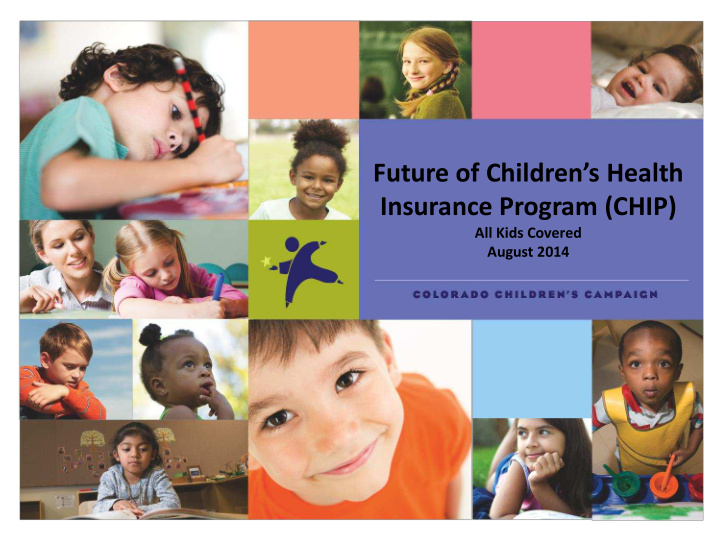



Future of Children’s Health Insurance Program (CHIP) All Kids Covered August 2014
Today’s Purpose • Quick Refresher on CHIP • Discussion of the future of CHIP • Opportunity for Engagement
CHIP Overview • Children’s Health Insurance Program (CHIP) is a federal / state partnership program – Federal government and state government share the cost – Federal government dictates some rules, state government makes some rules • Designed to provide health coverage for children and pregnant women – Benefits built to meet unique health care needs of pregnant women and children • Intended to serve children and pregnant women who don’t qualify for Medicaid but cannot afford private health insurance • Not an entitlement program, but rather a block grant program, meaning there are annual limits on what states receive
CHIP History • Children’s Health Insurance Program (CHIP) was created via the Balanced Budget Act of 1997. • Bi-partisan legislation championed by Senators Orrin Hatch (R-UT) and Ted Kennedy (D-MA). • In 2008 Congress secured bi-partisan support to reauthorize CHIP, but President Bush vetoed reauthorization twice. • In 2009 the Children’s Health Insurance Program Reauthorization (CHIPRA) was signed into law by President Obama. • In 2010 the Patient Protection and Affordable Care Act (ACA – or Obamacare) authorized the program to 2019, however approved financing of the program only to 2015
CHIP in Colorado: CHP+ • Colorado’s CHIP program is called the Child Health Plan Plus (CHP+) • CHP+ is a stand-alone program, separate from Medicaid – Note: some kids and pregnant women are in a combo Medi-CHIP plan • CHP+ covers children and pregnant women up to 250% FPL or $58,875 for a family of four who are not eligible for Medicaid and don’t have other health insurance – Note: because of new income eligibility rules under the ACA, many families with incomes up to 260% FPL can qualify for CHP+ • In many ways, CHP+ operates like private insurance – State contracts with four private insurance companies to administer CHP+ benefits – CHP+ has cost-sharing requirements including annual enrollment fees and co-pays – There are clearly defined benefits under CHP+ • 6/2014: HCPF reports there were 57,673 Coloradans enrolled in CHP+
Future of CHIP Program is federally authorized to 2019, but federal funding only secured to 2015, so what happens next? Key Policy Question: In the wake of health reform and creation of health exchanges and subsidized private coverage, is CHIP still needed? Key Political Question: Will Congress approve continued funding?
Future of CHIP Reasons Yes: Reasons No: • Medicaid expansion and new • It is working! coverage options through marketplaces have eliminated • Affordability purpose / need • Cost of program - Opportunity • Benefit Design to eliminate a government program • Access to Coverage • Keep family coverage together • “Kid Glitch” • Health care too divisive an • It has enjoyed historic bi-partisan issue in this political climate support
Future of CHIP Helpful Resources • Government Accounting Office (GAO) released a report comparing costs and benefits between CHIP and qualified health plans (QHPs) in 5 states, including CO. (Nov 2013) – Key findings: coverage is generally comparable, but costs significantly higher in QHPs. • MACPAC issues annual reports to Congress on Medicaid and CHIP and the June 2014 report focused on the future of CHIP – Recommends extending funding for a “transitional” period of 2 years beyond current 2015 expiration; during the two year period more fully explore the alternative coverage options for children covered by CHIP
Future of CHIP Helpful Resources • Georgetown Center for Children and Families and Center on Budget and Policy Priorities released preliminary findings on what discontinuation of federal CHIP funding would mean in terms of lost federal revenue for state budgets (June 2014) – CO would lose federal funding of $134 - $141M under current match rates; $181 - $191M under enhanced match rates • The Wakely Consulting Group released actuarial analysis conducted for the Robert Wood Johnson Foundation comparing out-of-pocket costs and benefits between CHIP and qualified health plans in 35 states, including CO. (July 2014) – Key findings: while coverage generally comparable, important benefit differences for specialty services, particularly re: limitations; out-of-pocket costs as much as 600% higher in QHPs
Future of CHIP Where Do We Stand Today? • Federal Legislation has been introduced in both the US Senate & House: CHIP Extension Act of 2014, Senator Jay Rockefeller (D-WV) // CHIP Extension & Improvement Act of 2014, Congressmen Waxman (D-CA) and Pallone (D-NJ) – Both extend funding to Sept 30, 2019, aligning authorization and funding dates – Both include provisions to improve program administration • This week the Chair and Ranking Members of the Committees of jurisdiction in Congress sent a letter to all Governors seeking their input on the continuation of CHIP – Governors have until Oct 31 st to respond • Timeline: Unlikely to see activity before elections, but potential for lame- duck session? If not, then to be taken up by new Congress in 2015. – Timing consideration: state budget cycles
Opportunity for Engagement All Kids Covered To Lead CHIP Financing Extension Advocacy Efforts • Sign on to lend your organization’s name to list of supporters – Email completed form to cody@coloradokids.org • Agree to raise awareness and spread the word – Educate your networks – Engage in social media • Contact your elected officials – Members of Congress, Governor Hickenlooper & State legislators (esp JBC members) – More coming soon on this… • Help put a face on the issue: CHIP success stories – Goal to collect 10 – 15 diverse stories of families that have benefitted from CHIP – Need people of different circumstances, different parts of the state; Can be families or providers
Questions? Cody Belzley 303.620.4560 cody@coloradokids.org
Recommend
More recommend